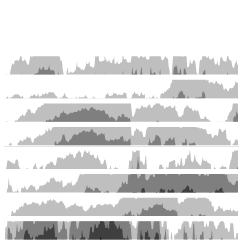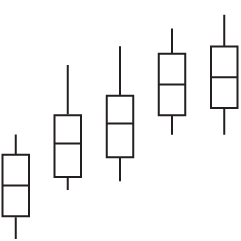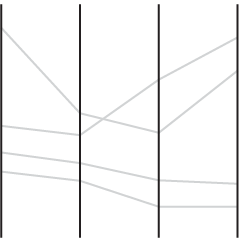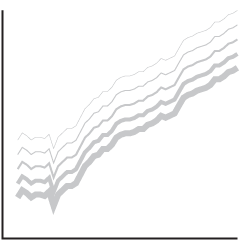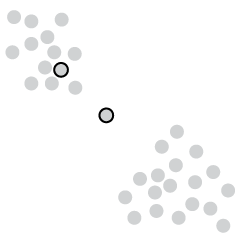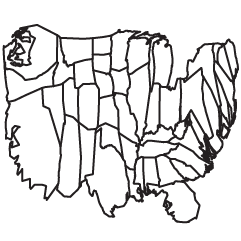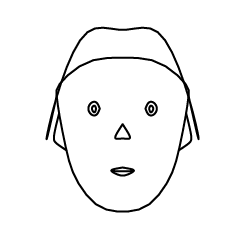Nike+ is a device you hook up to your shoe and iPod Nano to track your running patterns and receive feedback while you’re running. Already a million people around the world have been training with the device, with the U.S. putting up 2.4 million global training miles. This past Sunday was “the day the world stopped to run” in the Nike+ Human Race 10K.
Read More
-
-
Last month, FlowingData had a pretty good month moving up to rank 4,130 on Technorati and growing from about 4,000 subscribers to 4,500, so our community has grown a bit. Thank you to all of you who have been spreading the word!
In case you missed them, here are some of the best posts from August:
- Watch the Rise of Gasoline Retail Prices, 1993 – 2008
- It’s Like Google Maps with Sim City 2000 – OnionMap
- Map of Olympic Medals in Bubble + Geographic Form
- Britain From Above – Beautiful Use of Satellite Technology
- Visualize Genomes and Genomic Data – Circos
- Beginner’s Guide to FlowingData – A Guided Tour
- Is There a Market for Premium Online Data Visualization?
- Awesome Olympics Coverage By The New York Times
- Many Eyes Adds Wordle to its Extensive Visualization Toolbox
- 3 Worthwhile Alternatives to the Pie Chart
-
Stamen has taken a step towards the concrete with their recent Hurricane Tracker for MSNBC. From what I can tell, it updates every couple of hours or so. The tracker shows where Hurricane Gustav has been and where it’s headed and provides information on wind speed, ground speed, and location.
From the map we see a development from tropical depression in the Caribbean Sea, to a big category 4 over Pinar Del Rio, and then something between a category 3 and 2 as it moves over New Orleans. Gustav dwindles to a tropical storm as it moves towards Dallas. With mandatory evacuations of New Orleans starting yesterday, here’s to hoping everyone finds somewhere safe to stay.
-
Some will find this amusing while others won’t get it at all. If you don’t get it, consider yourself lucky. Have a good weekend, everyone.
[Thanks, Canna]
-
 I used to ride my bike to school, and I always forgot my U-lock. Instead of riding back for it, I’d just stash my bike unlocked in between a cluster of bikes. I told my friend jokingly, “It’ll be OK. 98% of people are good.” One day I got out of class, and my bike was stolen.
I used to ride my bike to school, and I always forgot my U-lock. Instead of riding back for it, I’d just stash my bike unlocked in between a cluster of bikes. I told my friend jokingly, “It’ll be OK. 98% of people are good.” One day I got out of class, and my bike was stolen.I was cleaning up some Actionscript in preparation for a tutorial post on how to make your own animated Walmart map, but a couple of bad memories involving stolen code and bad knockoffs (of my work) stopped me midway. I had to think:
Is releasing my code the best thing to do?
I’m sure the consensus is a resounding yes, but what’s to stop some lazy person from ripping off my code and pawning it off (or worse, selling it) as their own? What if I want to sell my visualizations? I am after all a lowly graduate student. It’d be nice to have another income stream.
On the other hand, had others before me not released their work under that wonderful BSD license, I would not be able to do what I do. At least not as easily. Modest Maps? Free. TweenFilterLite? Free. Flare Visualization Toolkit? Free. If I don’t follow suit, does that make me selfish? Yes, it does.
Giving Back to the Community
I’ve heard that phrase, giving back, so many times in both the real-life sense and the digital one, but it never made much sense to me. I mean, I got it, but I never really got it.
Perhaps I never understood it, because I wasn’t using much of the community’s resources nor did I have anything to give back. I have something to give back now. I can help people learn in the same way that others before me have and still do. I’m incredibly thankful to those who maintain these open source projects and still help me out from time to time when there’s really nothing in it for them.
The least I can do is continue to promote this idea of openness and help this small field of data visualization flourish into what it deserves to be. It’s why I blog, and it’s why I should give back, but to what extent?
Making the Case for Open Source Data Visualization
 My dilemma brought me back to a Data Evolution post on open source data visualization. It highlighted three things:
My dilemma brought me back to a Data Evolution post on open source data visualization. It highlighted three things:- Open Tools – As in freely available software tools like R and Processing.
- Open Code – How often have you seen a visualization and wondered, “How did they do that? If only the code were available.”
- Open Data – Oh so important in data visualization. The core. Open data means more people can try out different methods.
It’s not always possible to attain all three. For example, we pay money for software because the companies would not exist otherwise. It’s a business, and to think that software companies would develop a bunch of free software is unrealistic. Also, oftentimes, data just can’t be shared – usually because of privacy issues. Lastly, open code doesn’t make sense a lot of the time. The DE post grades The New York Times with a D for openness, but they’re a news business, not a visualization repository.
While we can’t always attain all of three things, there’s no reason why we can’t try to strive towards that ideal. As someone I know likes to say – strive for perfection. You might not reach that standard, but you could end up with something close.
Open source is a development method for software that harnesses the power of distributed peer review and transparency of process. The promise of open source is better quality, higher reliability, more flexibility, lower cost, and an end to predatory vendor lock-in.
Tweeting Thoughts
I of course tweeted this in the middle of the night while watching the day’s remaining olympic events – to release code or not to release code. Here are are some of the replies:
@rpj: To release, always! (When legally possible.)
@ehrenc: re: code. You could always release half the code :)
@pims to release code. There’s some brilliant people around that can build on top of what you did. Open world :)
As for me, well, let’s just say you should expect to see tutorials – complete with code – in the coming weeks.
-
Keep track of what’s getting reported about the presidential race in somewhat realtime with perspctv. It’s a nicely done news dasboard that updates on its own showing updates from CNN, Twitter, and the Blogosphere. It also shows poll results, predictions, daily reach, and search volume.
They’ve got charts (above); they’ve got maps:
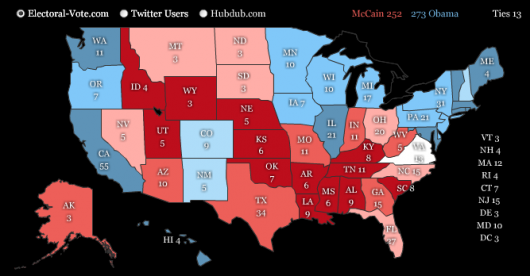
they’ve got timelines:

and they’ve got widgets:
In essence, it’s a news aggregater, but it’s a really good one and a great dashboard for you election junkies.
[Thanks, Iman]
-
As some commented on an earlier post, FusionCharts provides an easy way for people to hack together statistical graphics – sometimes not so attractively – and put the results on their websites. Widgenie serves as case in point. The concept of the application is all well and good. Upload some data and embed the “interactive” graphic on your blog, website, etc.
The realization of that idea however, needs some work. Aside from my difficulties logging on, changing my password, and non-flexible data upload, the widgets are, for the most part, just FusionCharts out of the box. Like the lollipop I made (below)?
[via ReadWriteWeb | Thanks, IA_chrissie]
-
I haven’t seen I.O.U.S.A. yet, but from the online bonus clips, it looks like it could be a good watch for you infographics junkies. The documentary examines the growing national debt and the consequences it will have on its citizens, so the source material sort of lends itself to plummeting time series charts with dramatic flare.
Here’s one showing personal savings rate over time:
Deficits and social security over time:
Debt-to-GDP projections:
A $53 Trillion Federal Financial Hole:
Those are just the bonus clips. I’m sure there are plenty more in the actual documentary.
[Thanks, @samkim]
-
A quick announcement – I just wanted to remind everyone (and point out to new readers) that there’s just one week left until the end of our summer project on personal visualization. I admittedly haven’t done a very good job of motivating all of you to this, but if you’d like a chance to win, submit by the end of September 1. Eternal glory is at stake.
-
GOOD Magazine, in collaboration with Graham Roberts, maps the most famous journeys in history – some fiction, some non-fiction. Wanderlust includes trips like Around the World in 80 Days and Journey to the Center of the Earth to the voyages of Marco Polo and Charles Lindbergh’s transatlantic flight. However, it’s not just a map with journey lines on it; Wanderlust is a history lesson. Select a trip for a summary and explore highlights of the journey.
-
“Analytics, at the end of the day, is going to be the endgame.” Ok, MC Hammer. If you say it is, then I will believe you. Have a nice weekend everyone, and remember, despite what you’ve heard, you’re never too legit to quit.
[via Juice Analytics]
-
I’m not sure how old this Disney org chart is, but I’m guessing very. Ink and paint? What are those? In any case, it’s amusing. Why are nurse, army coordinator, police, and morgue on there? The animation business is clearly more complex than I thought.
-
Fleshmap is a new project by Martin Wattenberg and Fernanda Vi̩gas that explores human desire from three points of view Рtouch, look, and listen.
Read More -
Speaking of physical graphs, looks it’s time management with my favorite childhood pastime – LEGOs! Each row represents an hour and each color indicates a different project. I’m gonna go out by myself a big, red bucket of LEGOs now.
[via infosthetics]
-
These wooden graphs by Joshua Callaghan show uh, something on the left and military spending on the right. While I wouldn’t call them any type of spectacular representation of data, I do like the idea of placing data into a physical space. We always get our graphs on a computer screen or on paper at best, which can take the human out of the data. It’s easy to forget that a single data point can represent an entire human life (or death). Keep that in mind the next time you analyze a dataset.
[via designboom | Thanks, Guðmundur]
-
I hope you’ll consider joining me on Blog Action Day on October 15 this year. It’s a day for bloggers around the world to all discuss one topic to raise awareness where attention is needed. Last year, 20,000 bloggers took part to discuss the environment. This year’s topic is poverty, and of course, we should all know by now that data visualization can play a huge role in showing that.
-
A while back I asked what you wanted to see more of on FlowingData. Thanks to the 447 of you who responded.
I was actually kind of surprised that there were so many votes for statistical visualization. I thought there would be more of a balance between design, art viz, and stat viz. I was, however, happy to see that the second most voted-on choice was “All of the Above.” I must be doing something right! So by popular demand, here’s some statistical visualization.
Pie Chart Alternatives
Since the above pie chart is making some of you cringe in agony (although I can’t imagine why), let’s take a look a few alternatives for the pie chart using the same poll results.
Bar Chart
How about a horizontal bar chart? The results are sorted and you can easily see the difference in voting counts.
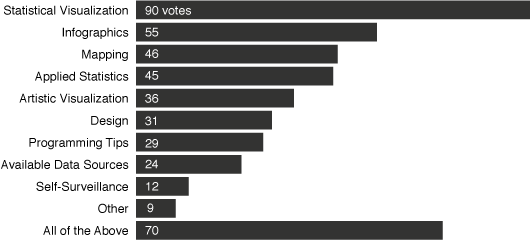
Stacked Bar Chart
The above bar chart is missing a little something though. It doesn’t explicitly show that each bar is really a part of a whole – in this case, all the people who voted. How about a stacked bar chart then? It shows the groupings and is a little easier to read than the pie chart in the sense that it’s linear differences as opposed to radial.

Bubble Chart
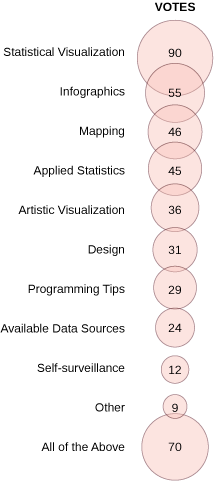 Let’s not forget our friends the bubbles. Carrying the same “problems” as a pie chart, the bubbles on the left are essentially a table with some flavor.
Let’s not forget our friends the bubbles. Carrying the same “problems” as a pie chart, the bubbles on the left are essentially a table with some flavor.Personally, I still like the pie. Which one do you think is best? Or is there something else that might have been better than the above? How about a mosaic plot? Donut graph? A plain table?
-
Timelines, much like calendars, can be used to show changes over time in a straightforward way. When you have a bunch of events that occurred at certain times, mark them on a timeline, and you quickly get a sense of what’s going on. Take the timeline of 10 largest data breaches for example. You see breaches get more dense as time goes by.
Wrap this idea into web application form, and you get Dippity. There have been similar timeline applications, but Dippity does it a bit better with a primary focus on telling stories with timelines and a good interface. Zoom in, zoom out, drag, and get alternative views as flipbook, list, and map.
Below is a little bit of context to my gas price chart. Check out the full version for a better idea of what Dippity offers. Read More
-
Ever since I posted my visualization that shows the spread of Walmart, I’ve gotten a lot of emails asking how I did it, if I’ve considered applying it to other datasets, or if I could help with a customized version of the Walmart visualization. I’ve gotten similar inquiries about the gas price graphic. This makes me wonder — is there a market for premium visualization online?
Existing Premium Visualization
I know there’s definitely a market for data-specific visualization – viz made specifically for a certain type of data – otherwise design groups like Bestiario and Stamen wouldn’t be around. But what about visualization that developers (or non-developers) can integrate into websites and applications with their own data?
FusionCharts
For example, FusionCharts lets developers integrate the more traditional visualizations like bar charts and basic maps into their websites. Everything runs in Flash and has a little bit of animation and some interaction. According to the site’s homepage, 30,000+ developers use FusionCharts. Licenses run from $69 for individuals to $1,999 for enterprise.
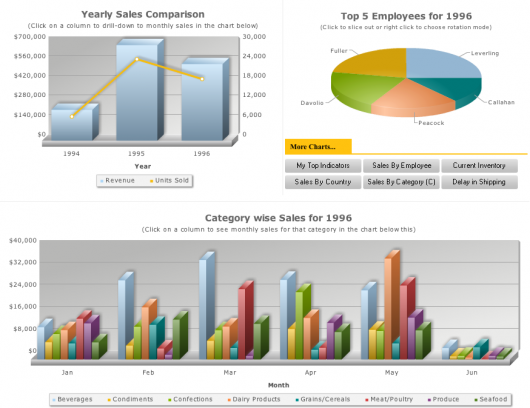
Constellation Roamer
Daniel develops Constellation Roamer. It’s a network graph interface that lets you explore connectedness. The Roamer has been out for about four months now and according to Daniel, has sold about 10 individual licenses at $550 each. This is interesting because the leads come from search engines without any advertising or publicity. While the sales are modest, he’s also gotten a lot of freelance work for customized versions of the Roamer to keep him plenty busy.
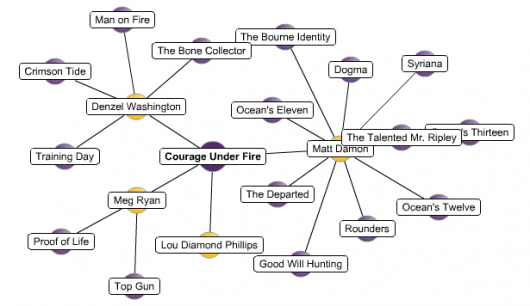
Relation Browser
Similarly, Moritz developed Relation Browser a couple years ago and says he gets an inquiry about once a week even though, like Daniel, doesn’t advertise. Relation Browser is a network graph visualization that lets you explore relationships. The example below shows relationships between countries, but can also be applied to something like a social network. Moritz releases his code for free, but requires commercial vendors to purchase a license for 400 Euros (about $600) each.
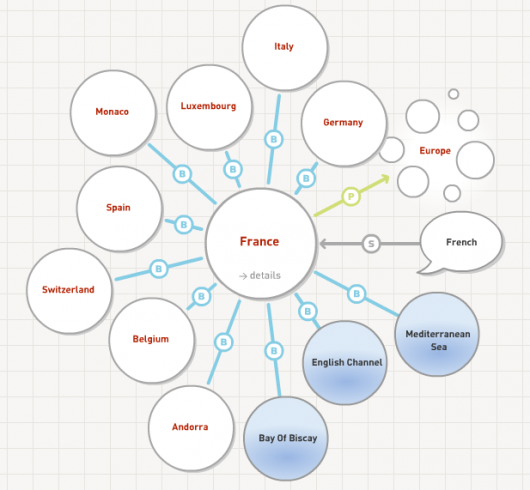
Free Visualization Tools
So there’s definitely some kind of demand for a more refined online visualization; however, there’s been a growing number of free visualization tools available to developers. Do these take away the need for paid online visualization tools?
Google Visualization API
Most well known is perhaps Google’s visualization API that they released in March, including the motion chart shown below. The API also includes a basic graphing utility along with a hodge podge of some other, uh, not so useful tools.
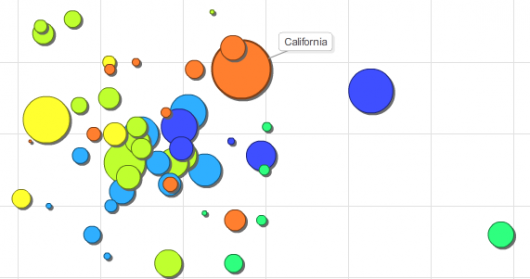
Many Eyes
Many Eyes promotes social data analysis and is best known for its interactive visualizations. Last year, they brought embeddable visualization, mostly for bloggers to share with others. However, the drawback is that you can’t push frequently-updated data into the Many Eyes application. The only way to get an updated visualization is to edit an existing dataset or upload a new one manually.
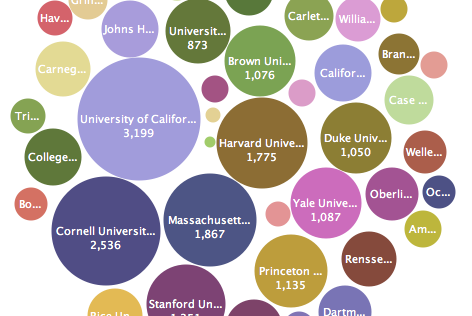
Room for Both Free and Premium
It seems that there’s room for both. While the free tools from Google and Many Eyes are useful in their own right, premium visualization can provide a higher level of customization (for complex data streams and aesthetics) and integration into a site or an application.
Tweeting Thoughts
I asked the same question on Twitter a few days ago and got some interesting responses from my Twitter friends:
@Omomyid: hmmmmm, how would you make it extensible though? The thing about cool infographics is that they are purpose built right?
@chris23: prolly a possible analyst service to provide visualizations/tools for market interests.
@der_mo: yes, totally. I keep selling the relation browser (http://der-mo.net/relationB…) although it is a couple of years old…
@hungryclone: maybe to companies w/ no dedicated employees that know how to make them?
Your Thoughts
What do you think? Is there a marketplace for visualization on the web or do the free APIs make it a moot point?
-
Who else has been enjoying the Olympics as much as I have? I think I might have developed an unhealthy obsession to the games these past few days with the 800 kajillion hours of NBC coverage.
Read More



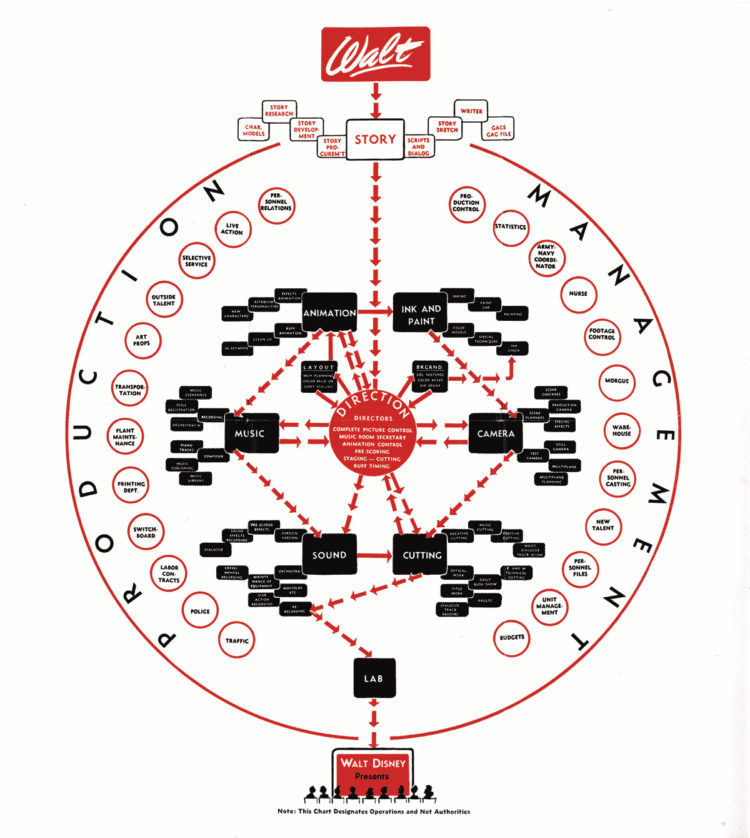


 Visualize This: The FlowingData Guide to Design, Visualization, and Statistics (2nd Edition)
Visualize This: The FlowingData Guide to Design, Visualization, and Statistics (2nd Edition)
